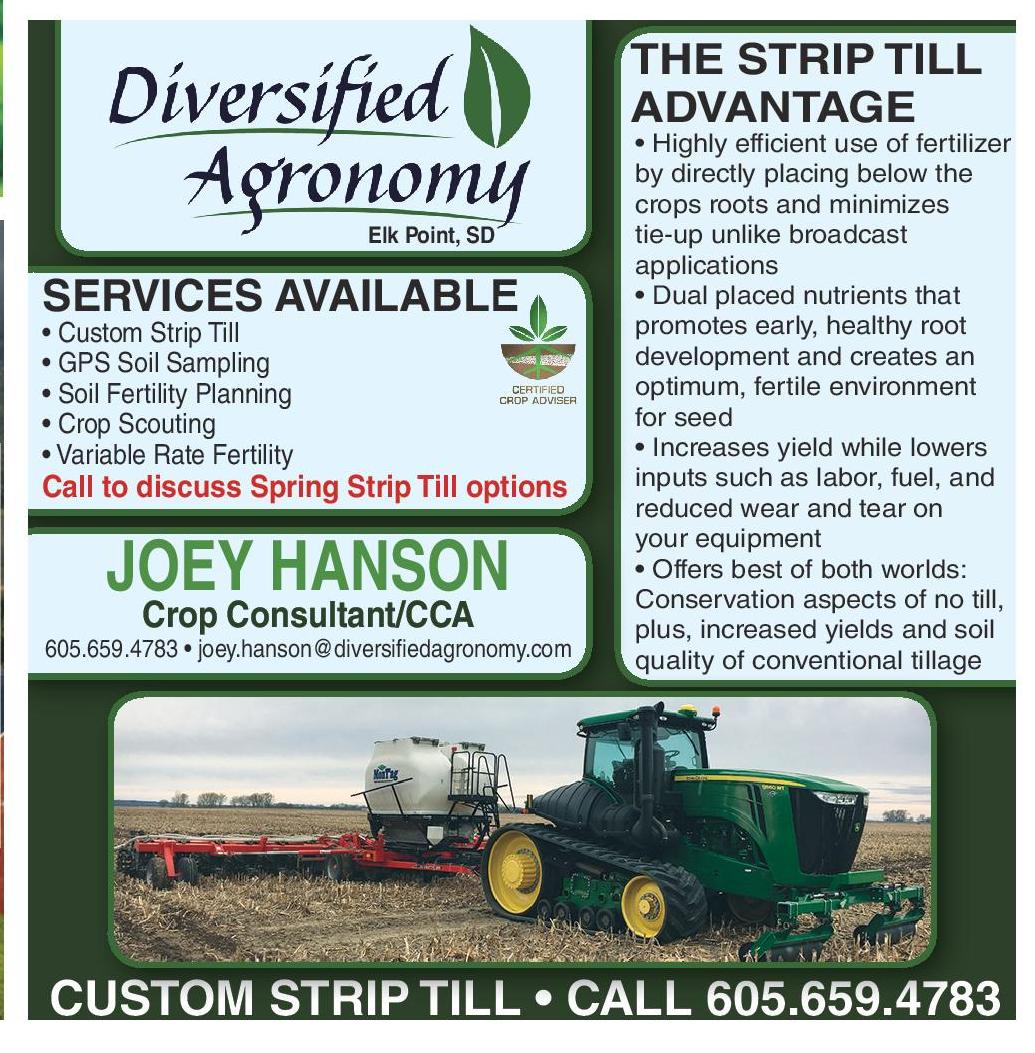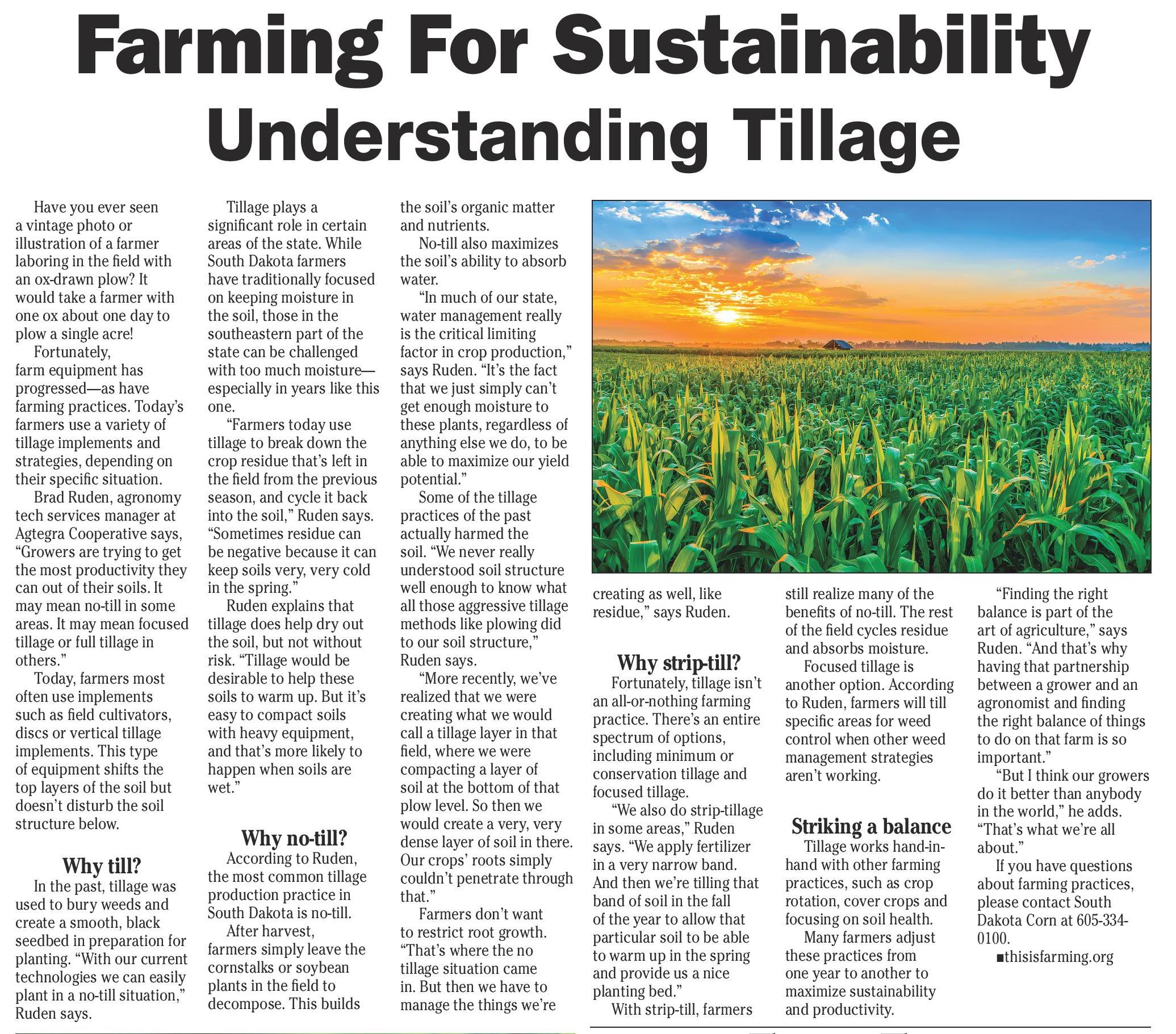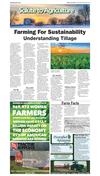032420_YKBP_A8.pdf






8 Broadcaster Press
March 24, 2020 www.broadcasteronline.com
Salute to Agriculture
Farming For Sustainability
Understanding Tillage
Have you ever seen
a vintage photo or
illustration of a farmer
laboring in the field with
an ox-drawn plow? It
would take a farmer with
one ox about one day to
plow a single acre!
Fortunately,
farm equipment has
progressed—as have
farming practices. Today’s
farmers use a variety of
tillage implements and
strategies, depending on
their specific situation.
Brad Ruden, agronomy
tech services manager at
Agtegra Cooperative says,
“Growers are trying to get
the most productivity they
can out of their soils. It
may mean no-till in some
areas. It may mean focused
tillage or full tillage in
others.”
Today, farmers most
often use implements
such as field cultivators,
discs or vertical tillage
implements. This type
of equipment shifts the
top layers of the soil but
doesn’t disturb the soil
structure below.
Why till?
In the past, tillage was
used to bury weeds and
create a smooth, black
seedbed in preparation for
planting. “With our current
technologies we can easily
plant in a no-till situation,”
Ruden says.
Tillage plays a
significant role in certain
areas of the state. While
South Dakota farmers
have traditionally focused
on keeping moisture in
the soil, those in the
southeastern part of the
state can be challenged
with too much moisture—
especially in years like this
one.
“Farmers today use
tillage to break down the
crop residue that’s left in
the field from the previous
season, and cycle it back
into the soil,” Ruden says.
“Sometimes residue can
be negative because it can
keep soils very, very cold
in the spring.”
Ruden explains that
tillage does help dry out
the soil, but not without
risk. “Tillage would be
desirable to help these
soils to warm up. But it’s
easy to compact soils
with heavy equipment,
and that’s more likely to
happen when soils are
wet.”
Why no-till?
According to Ruden,
the most common tillage
production practice in
South Dakota is no-till.
After harvest,
farmers simply leave the
cornstalks or soybean
plants in the field to
decompose. This builds
the soil’s organic matter
and nutrients.
No-till also maximizes
the soil’s ability to absorb
water.
“In much of our state,
water management really
is the critical limiting
factor in crop production,”
says Ruden. “It’s the fact
that we just simply can’t
get enough moisture to
these plants, regardless of
anything else we do, to be
able to maximize our yield
potential.”
Some of the tillage
practices of the past
actually harmed the
soil. “We never really
understood soil structure
well enough to know what
all those aggressive tillage
methods like plowing did
to our soil structure,”
Ruden says.
“More recently, we’ve
realized that we were
creating what we would
call a tillage layer in that
field, where we were
compacting a layer of
soil at the bottom of that
plow level. So then we
would create a very, very
dense layer of soil in there.
Our crops’ roots simply
couldn’t penetrate through
that.”
Farmers don’t want
to restrict root growth.
“That’s where the no
tillage situation came
in. But then we have to
manage the things we’re
creating as well, like
residue,” says Ruden.
Why strip-till?
Fortunately, tillage isn’t
an all-or-nothing farming
practice. There’s an entire
spectrum of options,
including minimum or
conservation tillage and
focused tillage.
“We also do strip-tillage
in some areas,” Ruden
says. “We apply fertilizer
in a very narrow band.
And then we’re tilling that
band of soil in the fall
of the year to allow that
particular soil to be able
to warm up in the spring
and provide us a nice
planting bed.”
With strip-till, farmers
still realize many of the
benefits of no-till. The rest
of the field cycles residue
and absorbs moisture.
Focused tillage is
another option. According
to Ruden, farmers will till
specific areas for weed
control when other weed
management strategies
aren’t working.
Striking a balance
Tillage works hand-inhand with other farming
practices, such as crop
rotation, cover crops and
focusing on soil health.
Many farmers adjust
these practices from
one year to another to
maximize sustainability
and productivity.
“Finding the right
balance is part of the
art of agriculture,” says
Ruden. “And that’s why
having that partnership
between a grower and an
agronomist and finding
the right balance of things
to do on that farm is so
important.”
“But I think our growers
do it better than anybody
in the world,” he adds.
“That’s what we’re all
about.”
If you have questions
about farming practices,
please contact South
Dakota Corn at 605-3340100.
?thisisfarming.org
Farm Facts
– According to most
recent U.S. Census Bureau
statistics, there are 386,531
men working as farmers
and ranchers. There are
51,865 women working as
farmers and ranchers.
– A farmer today grows
twice as much food as his
parents did – using less
land, energy, water, and
fewer emissions.
– Today, the average
U.S. farmer feeds 155
people. In 1960, a farmer
fed just 26 people.
– To keep up with
population growth more
food will have to be
produced in the next 50
years as the past 10,000
years combined.
– U.S. farmers produce
about 40 percent of the
world’s corn, using only 20
percent of the total area
harvested in the world.
– According to the
USDA, one acre of corn
removes about 8 tons of
carbon dioxide from the
air in a growing season.
At180 bushels per acre,
corn produces enough
oxygen to supply a year’s
needs for 131 people.
HOXENG CROP INSURANCE LLC
For Your Crop Insurance Needs
MPCI & Crop Hail
38 years of crop insurance experience
Dave Hoxeng • Tyler Hoxeng
44867 303rd St. • Volin, SD 57072
Office: 605-267-2767 • 1-855-969-2767
Dave’s Cell: 605-661-1136 • Tyler’s Cell: 605-661-7241
We are an Equal Opportunity Employer
THE STRIP TILL
THE STRIP TILL
THE STRIP TILL
ADVANTAGE
ADVANTAGE of fertilizer
• Highly efficient use
ADVANTAGE
Elk Point, SD
Elk Point, SD SD
Elk Point,
SERVICES AVAILABLE
SERVICES AVAILABLE
SERVICES AVAILABLE
Custom Strip Till
• Custom Strip
••Custom Strip TillTill
• Soil Sampling
GPSSoil Sampling
••GPSGPS Soil Sampling
••Soil• Fertility Planning
SoilSoil Fertility Planning
Fertility Planning
•
••CropCrop Scouting
CropScouting Fertility
Scouting
• Variable Rate
••Variable Rate Fertility
Variable Rate Fertility
Tractor Supply Company is the largest operator of rural
Call to discuss Spring Strip Till options
Call discuss Spring Strip Till options
lifestyle retail stores in America. Founded in 1938 as a mail Call to to discuss SpringStrip Till options
order tractor parts business, Tractor Supply Company (also
referred to as TSC) owns and operates over 1,600 stores in
Crop Consultant/CCA
49 states supplying a niche market for farmers, horse owners,
Crop Consultant/CCA
605.659.4783Consultant/CCA
Crop • joey.hanson@diversifiedagronomy.com
ranchers, part-time and hobby farmers, and suburban and
605.659.4783 joey.hanson@diversifiedagronomy.com
605.659.4783 • •joey.hanson@diversifiedagronomy.com
rural homeowners, as well as contractors and tradesmen.
TSC's products include: clothing, equine and pet supplies,
tractor/trailer parts and accessories, lawn and garden
supplies, sprinkler/irrigation parts, power tools, fencing,
welding and pump supplies, riding mowers and more.
JOEY HANSON
JOEY HANSON
JOEY HANSON
• Highly efficient use of use of the
• Highly efficient below
by directly placing fertilizer fertilizer
by crops roots placing the
directly placing below below
by directly and minimizes the
crops roots and minimizes
crops unlike and minimizes
tie-up roots broadcast
tie-up unlike broadcast
tie-up unlike
applications broadcast
applications
applications
• Dual placed nutrients that
• Dual placed nutrients that
• Dual placed healthy
promotes early,nutrients that
promotes early, healthy root root
promotes early, creates an
development and creates an
development andhealthy root
development and creates
optimum, fertile environment
optimum, fertile environmentan
optimum,
for for seed fertile environment
seed
for seed
• Increases yield while lowers
• Increases yield while lowers
• Increases yield while
inputs such as labor, fuel, and lowers
inputs such astear on fuel, and
labor,
reduced wear andas labor, fuel, and
inputs such
reduced wear and tear on
your equipment
reduced wear and tear on
your equipment
• Offers best of both worlds:
your equipment
Conservation aspects both till,
• Offers best of bothno worlds:
• Offers best of of worlds:
plus, increased yields and soil no till,
Conservation aspects ofof no till,
Conservation aspects
quality ofincreased yields and soil
plus, conventional tillage
plus, increased yields and soil
quality of conventional tillage
quality of conventional tillage
CUSTOM STRIP TILL • CALL 605.659.4783
Stop in today to your local TSC at 509 W. Cherry St. Vermillion
605-624-4000
CUSTOM STRIP TILL • CALL 605.659.4783
CUSTOM STRIP TILL • CALL 605.659.4783

















 Previous Page
Previous Page






